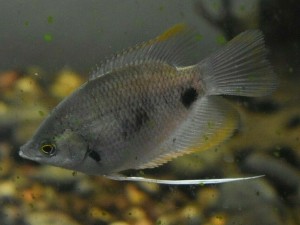Gouramis Care Requirements and Tank Selection for Hobbyists

Gouramis are called Air Breathers because of a special organ
Gouramis belong to the Osphronemidae, Helostomatidae, and Anabantidae families of fish. They have a labyrinth organ, which functions similarly to a lung and enables them to breathe air near the surface. This adaption allows them to exist in shallow, stagnant, oxygen-depleted water in nature. Some gouramis are mouthbrooders, whereas others build bubble nests on the surface to nurture their eggs until hatching. Males are often bigger than females, with brighter colors and longer fins. Different hues and fancier fins have been carefully bred into many species.
Where do Gouramis come from in nature?
Gouramis may be found all throughout eastern and southern Asia, from Pakistan to Thailand, Vietnam, the Malaysian Archipelago, China, and even Korea and Japan. Slow-moving rivers, swamps, marshes, canals, wetlands, and ephemeral ponds are where they reside.
What are the Gourami's Water Requirements?
Many gouramis live in soft, acidic water in the wild, but the majority of aquarium species available today are reared in water with a greater pH and alkalinity than their natural surroundings, making them very adaptable. The pH should be between 6.8 and 7.8, the alkalinity should be between 3 and 8 degrees dkH (50 ppm to 140 ppm), and the water temperature should be between 75 and 80 degrees F. If the aquarium is housed in a room with a temperature below 75°, an
Aquarium Heater should be used to maintain the proper temperature. Maintain adequate filtration and use an
Aquarium Water Changer or
Siphon Vacuum Gravel Cleaner to change 10% of the water weekly or 25% every two weeks. Before refilling your tank, be sure to treat the tap water with
Water Conditioner.
What are the Housing Requirements for Gouramis?
The size of the aquarium you'll require is determined by the kind of gourami you intend to maintain. Sparkling, croaking, honey, and dwarf gouramis may be maintained in tanks as little as 10 gallons, whereas pearl, blue, gold, opaline, and moonlight gouramis, as well as paradise fish, need a 30-gallon aquarium or more. When they reach full size, kissing gouramis will need a 55-gallon tank or more. The "True" or
Giant gourami, Osphronemus goramy, may grow to be 24" long and requires a 250 gallon tank or more. Because most gouramis like to be at the surface, tall plants or ones that float at the surface help them feel at ease. In a well-decorated aquarium, they will be less anxious and reveal their finest colors. To keep them from leaping out, keep a tight cover on the tank.
General Gouramis Behavior and Compatibility with Other Fish
Male gouramis have a reputation for being violent against one another, thus they should be kept apart. Female gouramis normally get along nicely with one another. Only bigger, well-decorated tanks should be used to mix various species or color types of gouramis. Remember that blue, three-spot, opaline, gold, and lavender gouramis are all the same fish with various colors bred into them! Gouramis are slow-moving fish that should be maintained with fish of comparable size that aren't fin nippers or too energetic. Tetras larger than fancy guppies, livebearers other than fancy guppies, peaceful barbs, most danios, and angelfish are also wonderful options. Before purchasing any new fish for your aquarium, always contact an aquarium professional.
What should I feed my Gouramis?
The majority of gouramis are omnivorous, thus
Tropical Flakes, Tropical Granules, and
Shrimp Pellets will suffice. Kissing gouramis are more herbivorous, hence
Spirulina Flakes and
Algae Rounds are recommended. Frozen and live items may be used as treats or to aid in the spawning process. Rotate their meals on a regular basis for optimal results, and only give them once or twice a day what they can ingest in under 2 minutes.
Gouramis Breeding Level - Intermediate
Many species of gourami can be raised in captivity, although raising the fry to maturity requires considerable effort. The majority of store-bought gouramis are bubble nest builders. The male courts the female after constructing a suitable nest on the surface, and the spawning procedure starts. The male collects the eggs when they are deposited and places them in the nest, which he protects until they hatch. After spawning, males may become hostile against females in order to protect the eggs from being eaten, and females may need to be removed.






